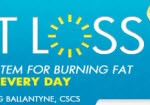

Metabolic Resistance Training Workouts Vs. Strength WorkoutsThe battle of metabolic workouts vs. strength workout has become epic.
Read More:
Metabolic Resistance Training Workouts Vs. Strength Workouts …


TweetSharebarTweetA recent reader question regarding the topic in my previous blog post has prompted me to delve a little deeper into intermittent fasting and how it differs from caloric restriction. To some, it may seem like the two concepts are the same thing but they are not. So, let me lay out the differences.Intermittent fasting is an eating pattern where one attempts to increase the time elapsed between meals on a semi-regular basis.Whereas the typical meal frequency might be three per day spaced out with four or five hours between them, a fasting person might skip breakfast (of course, since we’re not breaking the fast yet) and not eat their first meal until the normal midday lunch hour.Combined with the overnight fast which occurred during sleep, we could estimate a total fasting period of around 12-14 hours, depending on how much sleep was obtained.There are other ways to accomplish this, like skipping dinner instead or even fasting an entire day. However, the fast is typically ended with some sort of feast or large meal.
See the article here:
Intermittent Fasting Versus Caloric Restriction | Naturally Engineered


Intermittent Fasting 101 – How to Start Burning Fat SAME DAY cash advance Editor’s note: This was originally written in 2008 and has been updated over the years to give the best information for you to understand on how to get started with “Intermittent Fasting”. Enjoy!Starting Your Own “Intermittent Fasting” LifestyleThe biggest question I have gotten since starting this site (The “IF” Life) in 2008, is how to effectively use “Intermittent Fasting” (also known simply as “IF”, hence the name of the site) to achieve their goals and maximum results.It is also the main reason I started this website, to help spread all the information below.Results and goals can vary by each person with fat loss, muscle gain, better health, improved performance in your sport of choice and more. With all that also factors in the individuality of what is a person’s insulin resistance, current body composition (body-fat%), daily lifestyle, eating habits, macronutrient ratios (carbs/protein/fat), type of exercise program, frequency and volume of training, recovery demands, and so forth.What I am trying to hint at is that you are unlikely to find large groups of people with the exact same set of parameters and responses to an intermittent fasting protocol.What does this mean? Well just that you need to start with a basic intermittent fasting (or “feeding” as mentioned below) format, and then learn how to monitor results and adjust as you go.Even down the road things will change as you improve health, lower insulin resistance and maybe change performance and recovery needs. So nothing is really ever just one set way (as it shouldn’t have to be).Life is dynamic (always changing and evolving) and so should be the way you see your own journey for health and fitness.What is Intermittent Fasting (IF)?For those that may not be familiar to the term, intermittent fasting is just taking “intermittent” times of fasting (no food) and working them into your lifestyle.
Read more:
Intermittent Fasting 101 – How to Start Burning Fat | The IF Life
In my article titled “Why Cardio Is Not Your Answer to Weight Loss!” I talked about metabolic resistance training being the most important type of exercise to do for weight loss.Q: What exactly is “metabolic” resistance training?A: Metabolic resistance training, simply defined is: training with resistance that elevates your metabolism. The calories that you burn AFTER you train are what count in this type of training. The goal is to create more work for your body, restoring itself to pre-workout levels, so that you’re burning more calories for the next day and a half.
Taken from –


It’s official:HIIT training is AWESOME!!!Researchers from Heriot-Watt University in Edinburgh, Scotland have concluded that:The efficacy of a high intensity exercise protocol, involving only 250 kcal of work each week, to substantially improve insulin action in young sedentary subjects is remarkable. This novel time-efficient training paradigm can be used as a strategy to reduce metabolic risk factors in young and middle aged sedentary populations who otherwise would not adhere to time consuming traditional aerobic exercise regimes.Art by Bill Hall – billhall.comAnd for those of you that don’t know, here are the risk factors of Metabolic Syndrome that HIIT training is so effective at reducing:Abdominal obesity (excessive fat tissue in and around the abdomen) Atherogenic dyslipidemia (blood fat disorders — high triglycerides, low HDL cholesterol and high LDL cholesterol — that foster plaque buildups in artery walls) Elevated blood pressure Insulin resistance or glucose intolerance (the body can’t properly use insulin or blood sugar) Prothrombotic state (e.g., high fibrinogen or plasminogen activator inhibitor–1 in the blood) Proinflammatory state (e.g., elevated C-reactive protein in the blood) People with the metabolic syndrome are at increased risk of coronary heart disease and other diseases related to plaque buildups in artery walls (e.g., stroke and peripheral vascular disease) and type 2 diabetes. It’s estimated that over 50 million Americans have it.And I am 100% sure that you don’t want it.So, what do you need to do?Go to your doctor and get checked out – Max intensity sprints combined with a sky high B.P. is just asking for trouble. Go through my HIIT resources Find an exercise bike, set of stairs, outdoor track or even a carpeted area in your home to do burpees Schedule 3 x 15 minute HIIT workouts per week Get HIITing And I am serious about the doctor.
Source article:
HIIT Training: The Cure for Type 2 Diabetes and Obesity? – Health …


Being the first entry on this website, QuickDiets.org – I am going to share with you something that will be actually helpful in your goal to get the body you desire!Scratch that – This book is what you MUST READ to lose fat if you do not want to be concerned about counting calories and watching what you eat and what not.==> Let’s look at intermittent fasting in a different perspective with this review of Eat Stop Eat by Brad Pilon.The Introduction of Eat Stop EatBrad’s Eat Stop Eat system has become really popular amongst the media and everybody who wants an easy way to lose body fat without having to count calories or stick to a time table of eating 5 to 6 meals a day.There is nothing complicated in this method. It is simple a book that shows you how to live your life the way you want without having to limit your self in watching what you eat or staring at that clock to eat every 2 to 3 hours or counting calories and portion sizes of everything you eat.>> Click Here for Try on the Eat Stop Program for $9.99I personally don’t like being controlled. I have a big family and in order to socialize well especially with my work and my business, I really get stressed out with all of the problems I mentioned above.How Does Eat Stop Eat Work?What the diet basically suggests is that you follow one or two 24 hour fasting periods twice a week where you will eat nothing but stick to water and zero calorie foods and beverages.That’s just the conclusion of Brad Pilon’s powerful book, but the principles behind this system and the right way to make it work to lose a lot of fat fast is outstanding.In order to lose 1 lb of body fat, you need to burn 3500 calories. When you eat normal five days a week and perform one or two 24 hour fast periods, you basically cut down on a calorie intake of over 1500 to 3500 calories!Of course you will now be worried about starvation mode and muscle loss
Original article:
Brad Pilon's Eat Stop Eat Reviewed – The Verdict is… | QuickDiets.org
Intermittent Fasting 23 Comments Saturday, November 10th, 2007 I received the following email from Xuan Mai who works out at Crossfit NYC. She emailed me a few months ago asking a few questions pertaining to paleo eating and intermittent fasting. Here is what Xuan Mai had to say:Hi Robb,I thought I would give you an update after my first month of Intermittent Fasting especially after the article by you that I read recently on Art Devany’s blog.The first week of IF’ing was difficult but it has gotten better. My fasts are typically between 16-19 hours and I am consuming a predominantly Paleo diet (no grains, no dairy but I do drink caffeinated tea and the once a week espresso). My activity consists of 4 Crossfit workouts per week.
View original: